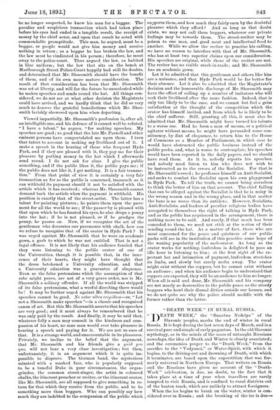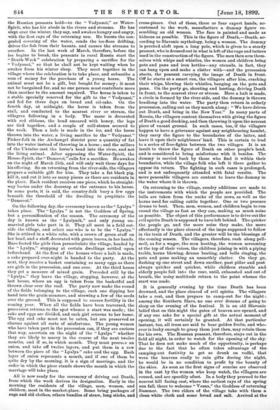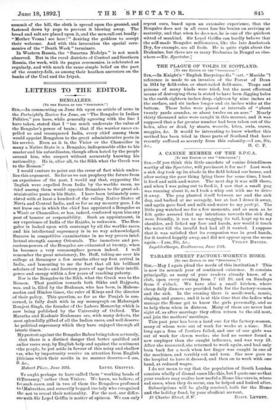"DEA TH WEEK" IN RURAL RUSSIA.
When the ice begins to break on the water, winter is con- sidered over in Russia ; and the breaking of the ice is due—.
the Russian peasants hold—to the " Vodyanoi," or Water. Spirit, who has his abode in the rivers and streams. He has slept over the winter, they say, and awakes hungry and angry, with the first rays of the returning sun. He bursts the con- gealed covering of the water, sends the ice-floes drifting, drives the fish from their haunts, and causes the streams to overflow. In the last week of March, therefore, before the ice begins to break, the peasants in rural Russia start the Death-Week" celebration by preparing a sacrifice for the " Vodyanoi," so that he shall not be kept waiting when he awakes from his winter sleep. They meet together in the village where the celebration is to take place, and subscribe a sum of money for the purchase of a young horse. The animal must not be a gift, but bought for money ; it must not be bargained for, and no one person must contribute more than another to the amount required. The horse is taken to a stable specially reserved for the gift to the " Vodyanoi," and fed for three days on bread and oil-cake. On the fourth day, at midnight, the horse is taken from the stall, and conducted to the nearest river or stream, the villagers following in a body. The mane is decorated with red ribbons, the head smeared with honey, the legs are tied together, and a couple of mill-stones secured to the neck. Then a hole is made in the ice, and the horse thrown into the water, a living sacrifice to the " Vodyanoi." Fisher-folk in the Archangel district pour a quantity of fat into the water instead of throwing in a horse ; and the millers of the Ukraine cast the horse's head into the river, and not the living animal. After appeasing the Water-Spirit, the House-Spirit, the " Domovoi," calls for a sacrifice. He awakes on the night of March 25th, and will only wait three days for his offering. So on returning from the river-side, the villagers prepare a suitable gift for him. They take a fat black pig, kill it, and cut it into as many pieces as there are residents in the place. Each resident receives one piece, which he straight- way buries under the doorstep at the entrance to his house. In some parts, it is said, the country-folk bury a few eggs beneath the threshold of the dwelling to propitiate the " Domovoi."
On the following day, the ceremony known as the" Lyalya " takes place. The " Lyalya " is not the Goddess of Spring, but a personification of the season. The ceremony of the day is known as the " Lyalynik," and only young un- married girls take part in it. They all meet in a field out- side the village, and select one who is to be the " Lyalya." She is attired in a white robe, with a crown of green stuff on her head, and a staff, decorated with green leaves, in her hands. Bare-footed the girls then perambulate the village, headed by the " Lyalya," stopping at certain dwellings settled upon beforehand. At the first of the houses where a halt is made, a cake prepared over-night is handed to the party. At the next, they receive a basket containing as many eggs as there are girls in the procession, and one over. At the third house they get a measure of mixed grain. Preceded still by the "Lyalya," they leave the village, stopping, however, at the last house, where an egg is taken from the basketful and thrown clear over the roof. The party now make the round of the fields belonging to the village, each one dipping her hand into the grain-measure, and strewing a few of the seeds over the ground. This is supposed to ensure fertility in the coming year. When all the fields have been traversed, the procession returns to the spot whence a start was made ; the cake and eggs are divided, and each girl returns to her home. The egg and cake must not be eaten, but are preserved as charms against all sorts of misfortune. The young women who have taken part in the procession can, if they are curious that way, ascertain on the night of the " Lyalya " whether they are likely to marry in the course of the next twelve months, and if so, in which month. They must procuze an onion, and take off twelve layers, and put them in a row between the piece of the " Lyalya" cake and the egg. Each layer of onion represents a month, and if one of them be quite dry by the morning, it is a sign of marriage, and the order in which the piece stands shows the month in which the marriage will take place.
All is now ready for the ceremony of driving out Death, from which the week derives its designation. Early in the morning the residents of the village, men, women, and children, meet in the market-place. Some bring packages of zags and old clothes, others bundles of straw, long sticks, and cross-pieces. Out of these, three or four expert hands, ac- customed to the work, manufacture a dummy figure re- sembling an old woman. The face is painted and made as hideous as possible. This is the figure of Death,—Death, ac= cording to Slavonic mythology, being a woman. The dummy is perched aloft upon a long pole, which is given to a sturdy peasant, who is dressed out in what is left of the rags and tatters used in the construction of the figure. The men then arm them- selves with whips and whistles, the women and children bring pots and pans and iron kettles—any utensils, in fact, they can bang upon and make a clatter with—and the procession starts, the peasant carrying the image of Death in front.
Off he starts at a smart run, the villagers after him, cracking their whips, blowing their whistles, banging on the pots and pans. On the party go, shouting and hooting, driving Death in front, to the nearest river or stream. Here a halt is made, a circle is formed by the river-side, and the dummy is thrown headlong into the water. The party then return in orderly procession, calling out as they march along : "We have driven out Death, and bring in the New Year." In many parts of Russia, the villagers content themselves with giving the figure of Death a good ducking, and then throwing it upon the nearest piece of vacant ground. In such cases, too, if the villagers happen to have a grievance against any neighbouring hamlet, they carry the figure to the boundaries of the latter, and leave it upon their neighbours' land. This is certain to lead to a series of free-fights between the two villages. It is an insult to throw the figure of Death on other people's land, and is considered to bring misfortune with it besides. The dummy is carried back by those who find it within their boundaries, while the village folk who left it there gather to oppose its return. The fighting in such cases is prolonged and is not unfrequently attended with fatal results. The more peaceable villagers are content to leave the dummy in the water where it is thrown.
On returning to the village, sundry additions are made to the instruments with which the people are provided. The bells are taken from the necks of the cows, as well as the horns used for calling cattle together. One or two procure drums to beat. Then, men, women, and children begin to ran round the village as fast as they can, making as much noise as possible. The object of this performance is to drive out the evil spirits Death is supposed to have left behind. The quicker the people go, and the more noise they make, the more effectually is the place cleared of the imps supposed to follow in the train of Death, and the greater will be the blessings of the coming season. The villagers, therefore, rush along pell- mell, as for a wager, the men hooting, the women screaming at the top of their voices, the children joining in with a piping treble, horns blowing, drums beating, and bells ringing, the pots and pans making an unearthly clatter. On they go, dashing up one street and down another, past pillar and post always quicker and quicker, while children stumble an& elderly people fall into the rear, until, exhausted and out of breath, the noisy multitude return to the point whence the start was made.
It is generally evening by the time Death has been drowned, and the place cleared of evil spirits. The villagers take a rest, and then prepare to camp-out for the night :- among the Southern Slays, no one ever dreams of going to- sleep on the evening of the festival. It is an old Slavonic belief that on this night the gates of heaven are opened, and- if any one asks for a special gift at the actual moment of opening, it will certainly be granted. At that particular instant, too, all trees are said to bear golden fruits, and who- ever is lucky enough to grasp them just then, may retain them for his own. The Russian peasant, therefore, stays out in the field all night, in order to watch for the opening of the sky: That he does not make much of the opportunity, is perhape due to the fact that he often takes advantage of the camping-out festivity to get so drunk on vodki, that were the heavens really to rain gifts during the night, he would be in no condition to profit by the bounty of
the skies. As soon as the first signs of sunrise are observed in the east by the women who keep watch, the villagers are roused, and are speedily afoot. In a body they proceed to the nearest hill facing east, where the earliest rays of the spring sun fall, there to welcome " Vesna," the Goddess of returning Summer. The two elders of the village take with them a clean white cloth and some bread and salt. Arrived at the
summit of the hill, the cloth is spread upon the ground, and fastened down by pegs to prevent it blowing away. The bread and salt are placed upon it, and the men call out loudly : "Mother Vesna! see here !" desiring the goddess to accept their welcome. And with this invocation the special cere- monies of the "Death Week" terminate.
In Western Russia, the "Smartna Nedelya " is not much observed. But in the rural districts of Central and Southern Russia, the week, with its pagan ceremonies, is celebrated as regularly, and with much the same simple belief on the part of the country-folk, as among their heathen ancestors on the banks of the Ural and the Irtysh.








































 Previous page
Previous page